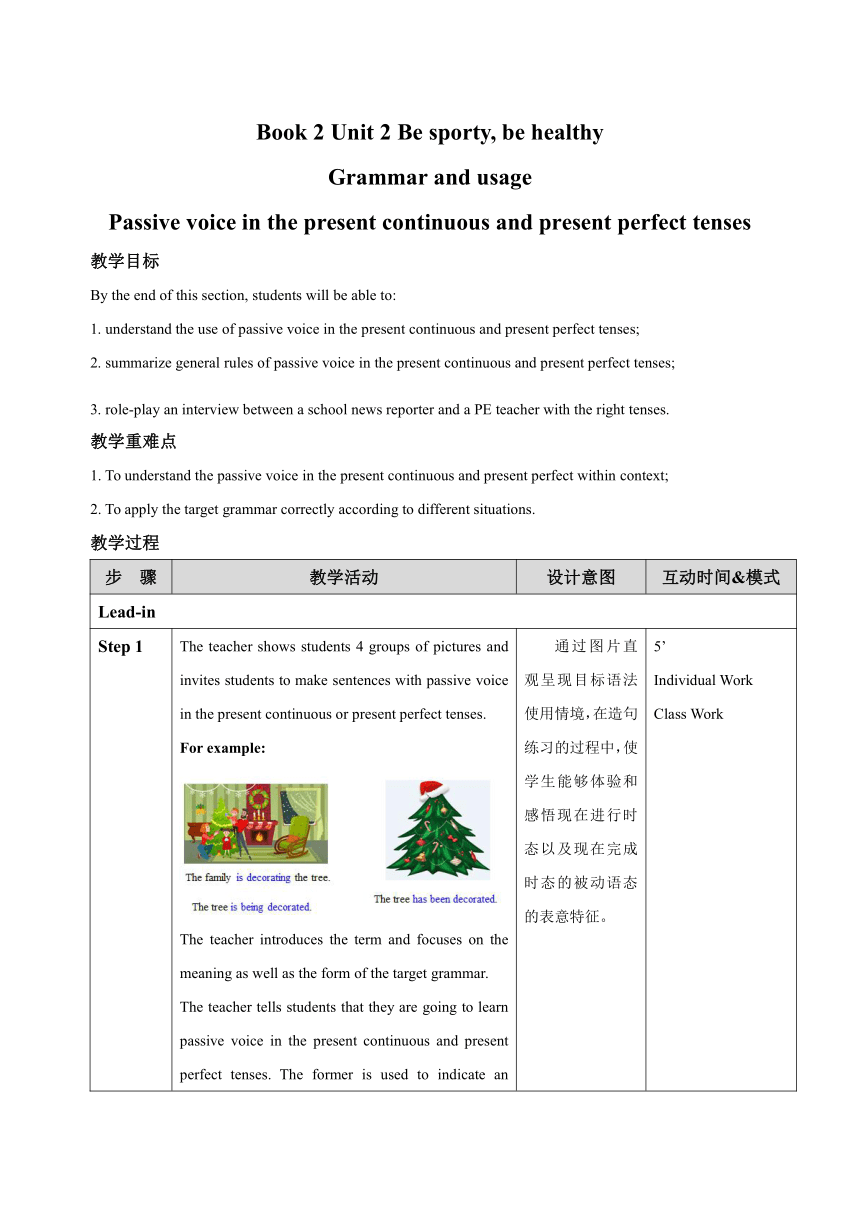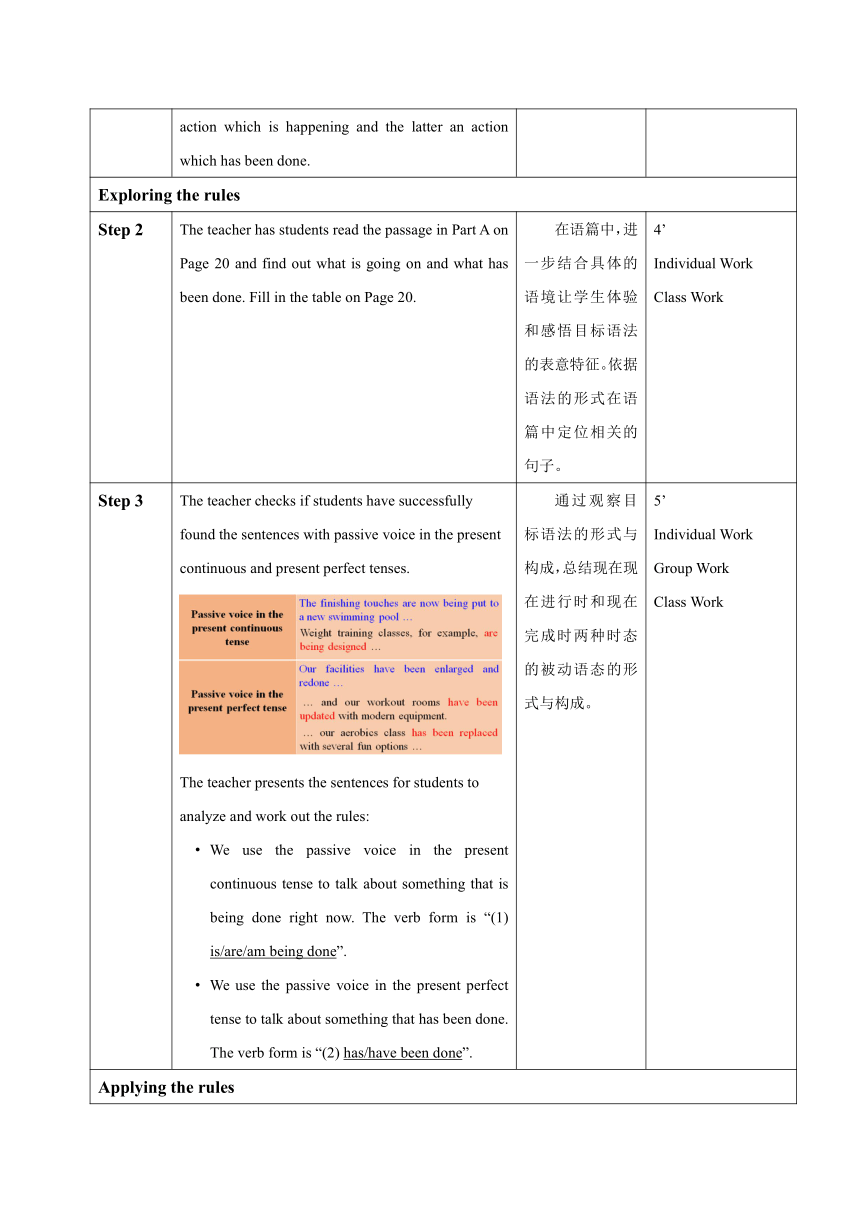牛津译林版(2019)必修 第二册 Unit2 Be sporty,be healthy Grammar and usage教案(表格式)
文档属性
| 名称 | 牛津译林版(2019)必修 第二册 Unit2 Be sporty,be healthy Grammar and usage教案(表格式) |  | |
| 格式 | docx | ||
| 文件大小 | 204.2KB | ||
| 资源类型 | 教案 | ||
| 版本资源 | 牛津译林版(2019) | ||
| 科目 | 英语 | ||
| 更新时间 | 2022-04-10 08:33:25 | ||
图片预览


文档简介
Book 2 Unit 2 Be sporty, be healthy
Grammar and usage
Passive voice in the present continuous and present perfect tenses
教学目标
By the end of this section, students will be able to:
1. understand the use of passive voice in the present continuous and present perfect tenses;
2. summarize general rules of passive voice in the present continuous and present perfect tenses;
3. role-play an interview between a school news reporter and a PE teacher with the right tenses.
教学重难点
1. To understand the passive voice in the present continuous and present perfect within context;
2. To apply the target grammar correctly according to different situations.
教学过程
步 骤 教学活动 设计意图 互动时间&模式
Lead-in
Step 1 The teacher shows students 4 groups of pictures and invites students to make sentences with passive voice in the present continuous or present perfect tenses. For example: The teacher introduces the term and focuses on the meaning as well as the form of the target grammar. The teacher tells students that they are going to learn passive voice in the present continuous and present perfect tenses. The former is used to indicate an action which is happening and the latter an action which has been done. 通过图片直观呈现目标语法使用情境,在造句练习的过程中,使学生能够体验和感悟现在进行时态以及现在完成时态的被动语态的表意特征。 5’ Individual Work Class Work
Exploring the rules
Step 2 The teacher has students read the passage in Part A on Page 20 and find out what is going on and what has been done. Fill in the table on Page 20. 在语篇中,进一步结合具体的语境让学生体验和感悟目标语法的表意特征。依据语法的形式在语篇中定位相关的句子。 4’ Individual Work Class Work
Step 3 The teacher checks if students have successfully found the sentences with passive voice in the present continuous and present perfect tenses. The teacher presents the sentences for students to analyze and work out the rules: We use the passive voice in the present continuous tense to talk about something that is being done right now. The verb form is “(1) is/are/am being done”. We use the passive voice in the present perfect tense to talk about something that has been done. The verb form is “(2) has/have been done”. 通过观察目标语法的形式与构成,总结现在现在进行时和现在完成时两种时态的被动语态的形式与构成。 5’ Individual Work Group Work Class Work
Applying the rules
Step 4 The teacher has students observe the two pairs of sentences and figure out the steps to change a sentence into passive voice. The postman has delivered the mail. (Active) The mail has been delivered (by the postman). (Passive) The decorator is painting my room. (Active) My room is being painted (by the decorator). (Passive) Steps: Step 1: Move the object to the beginning of the sentence. Step 2: Change the verb from active form to passive form, maintaining the sentence tense. Step 3: Add the preposition “by” before the subject if you want to mention the subject, but it’s optional. 引导学生结合实例,明确主动变被动的一般步骤,为后面的操练做好准备和铺垫。 3’ Individual Work Class Work
Step 5 The teacher has students focus on some special occasions. Note 1 If there is a preposition between the verb and the object, the preposition will remain after the verb. They have talked about the issue. (Active) The issue has been talked about. (Passive)
Note 2 Some sentences have both a direct object (usually a thing) and an indirect object (usually a person). You can choose either one to formulate the passive sentence. They have sent us a copy. (Active ) We have been sent a copy. (Passive) A copy has been sent to us. (Passive)
通过特例的介绍,使学生更加全面深入地理解被动语态这一语法项目。 3’ Individual Work Class Work
Step 6 The teacher has students finish Part B1 on Page 21. Keys: 1. A new community sports centre is being built (by the city government). 2. The walls in the workout rooms are being painted (by some workers). 3. I have been told that the new workout rooms are very modern. 4. Jenny has been asked to make an exercise plan (by her PE teacher). 5. Students are being tested on their knowledge of fitness (by the teachers). 在转换练习中灵活运用两种被动语态的结构,聚焦它们的形式。 6’ Individual Work Class Work
Step 7 The teacher has students finish Part B2 on Page 21. Keys: 1. are being made 2. have been put 3. are being tested 4. have been designed 5. has been built 在语篇填空练习中灵活运用两种被动语态的结构,并结合具体的语境使用目标语法。 5’ Individual Work Class Work
Step 8 The teacher has students finish Part B3 on Page 21. Sample answer: Reporter: Mr Lin, thank you for agreeing to this interview. May I ask what has been prepared for the sports meeting Mr Lin: Well, the date of the sports meeting has been decided: 14 May. Reporter: What about the location Mr Lin: The location has been decided. The sports meeting will be held in the new school sports centre. Reporter: How many sports events will there be for the sports meeting this year Mr Lin: Last year, we had 30 medal events. Five more are being considered for this year. Reporter: What are the rules for each sport Mr Lin: They haven’t been decided yet. Reporter: Has all the equipment been put in place yet Mr Lin: No. The equipment is being prepared for now. Reporter: Thank you for your time, Mr Lin. I hope the school sports meeting will be a great success! 通过语言情境的营造,帮助学生灵活运用目标语法,更好地理解目标语法的表意功能。 7’ Individual Work Pair Work
Step 9 The teacher invites student to describe a situation with as many sentences with passive voice in the present continuous or present perfect tenses as possible. 在全新的语言情境中,要求学生使用目标语法对相关事件进行描述。 5’ Individual Work Class Work
Homework 1. Describe a self-chosen situation using as many sentences with passive voice in the present continuous and present perfect tenses as possible. 2. Finish Part C on Page 64 in the workbook. 2’
Grammar and usage
Passive voice in the present continuous and present perfect tenses
教学目标
By the end of this section, students will be able to:
1. understand the use of passive voice in the present continuous and present perfect tenses;
2. summarize general rules of passive voice in the present continuous and present perfect tenses;
3. role-play an interview between a school news reporter and a PE teacher with the right tenses.
教学重难点
1. To understand the passive voice in the present continuous and present perfect within context;
2. To apply the target grammar correctly according to different situations.
教学过程
步 骤 教学活动 设计意图 互动时间&模式
Lead-in
Step 1 The teacher shows students 4 groups of pictures and invites students to make sentences with passive voice in the present continuous or present perfect tenses. For example: The teacher introduces the term and focuses on the meaning as well as the form of the target grammar. The teacher tells students that they are going to learn passive voice in the present continuous and present perfect tenses. The former is used to indicate an action which is happening and the latter an action which has been done. 通过图片直观呈现目标语法使用情境,在造句练习的过程中,使学生能够体验和感悟现在进行时态以及现在完成时态的被动语态的表意特征。 5’ Individual Work Class Work
Exploring the rules
Step 2 The teacher has students read the passage in Part A on Page 20 and find out what is going on and what has been done. Fill in the table on Page 20. 在语篇中,进一步结合具体的语境让学生体验和感悟目标语法的表意特征。依据语法的形式在语篇中定位相关的句子。 4’ Individual Work Class Work
Step 3 The teacher checks if students have successfully found the sentences with passive voice in the present continuous and present perfect tenses. The teacher presents the sentences for students to analyze and work out the rules: We use the passive voice in the present continuous tense to talk about something that is being done right now. The verb form is “(1) is/are/am being done”. We use the passive voice in the present perfect tense to talk about something that has been done. The verb form is “(2) has/have been done”. 通过观察目标语法的形式与构成,总结现在现在进行时和现在完成时两种时态的被动语态的形式与构成。 5’ Individual Work Group Work Class Work
Applying the rules
Step 4 The teacher has students observe the two pairs of sentences and figure out the steps to change a sentence into passive voice. The postman has delivered the mail. (Active) The mail has been delivered (by the postman). (Passive) The decorator is painting my room. (Active) My room is being painted (by the decorator). (Passive) Steps: Step 1: Move the object to the beginning of the sentence. Step 2: Change the verb from active form to passive form, maintaining the sentence tense. Step 3: Add the preposition “by” before the subject if you want to mention the subject, but it’s optional. 引导学生结合实例,明确主动变被动的一般步骤,为后面的操练做好准备和铺垫。 3’ Individual Work Class Work
Step 5 The teacher has students focus on some special occasions. Note 1 If there is a preposition between the verb and the object, the preposition will remain after the verb. They have talked about the issue. (Active) The issue has been talked about. (Passive)
Note 2 Some sentences have both a direct object (usually a thing) and an indirect object (usually a person). You can choose either one to formulate the passive sentence. They have sent us a copy. (Active ) We have been sent a copy. (Passive) A copy has been sent to us. (Passive)
通过特例的介绍,使学生更加全面深入地理解被动语态这一语法项目。 3’ Individual Work Class Work
Step 6 The teacher has students finish Part B1 on Page 21. Keys: 1. A new community sports centre is being built (by the city government). 2. The walls in the workout rooms are being painted (by some workers). 3. I have been told that the new workout rooms are very modern. 4. Jenny has been asked to make an exercise plan (by her PE teacher). 5. Students are being tested on their knowledge of fitness (by the teachers). 在转换练习中灵活运用两种被动语态的结构,聚焦它们的形式。 6’ Individual Work Class Work
Step 7 The teacher has students finish Part B2 on Page 21. Keys: 1. are being made 2. have been put 3. are being tested 4. have been designed 5. has been built 在语篇填空练习中灵活运用两种被动语态的结构,并结合具体的语境使用目标语法。 5’ Individual Work Class Work
Step 8 The teacher has students finish Part B3 on Page 21. Sample answer: Reporter: Mr Lin, thank you for agreeing to this interview. May I ask what has been prepared for the sports meeting Mr Lin: Well, the date of the sports meeting has been decided: 14 May. Reporter: What about the location Mr Lin: The location has been decided. The sports meeting will be held in the new school sports centre. Reporter: How many sports events will there be for the sports meeting this year Mr Lin: Last year, we had 30 medal events. Five more are being considered for this year. Reporter: What are the rules for each sport Mr Lin: They haven’t been decided yet. Reporter: Has all the equipment been put in place yet Mr Lin: No. The equipment is being prepared for now. Reporter: Thank you for your time, Mr Lin. I hope the school sports meeting will be a great success! 通过语言情境的营造,帮助学生灵活运用目标语法,更好地理解目标语法的表意功能。 7’ Individual Work Pair Work
Step 9 The teacher invites student to describe a situation with as many sentences with passive voice in the present continuous or present perfect tenses as possible. 在全新的语言情境中,要求学生使用目标语法对相关事件进行描述。 5’ Individual Work Class Work
Homework 1. Describe a self-chosen situation using as many sentences with passive voice in the present continuous and present perfect tenses as possible. 2. Finish Part C on Page 64 in the workbook. 2’
